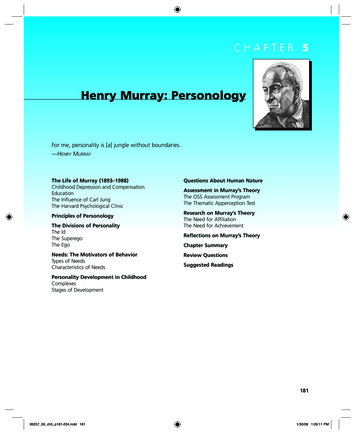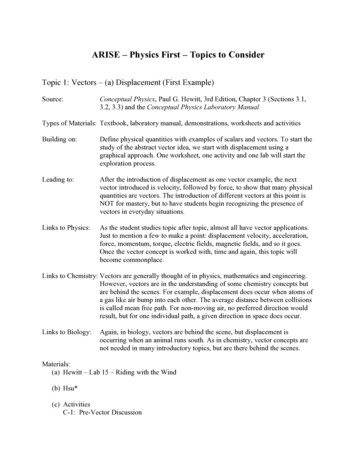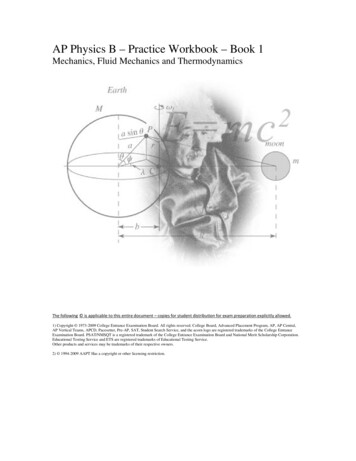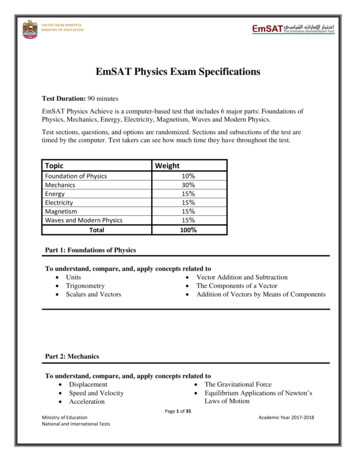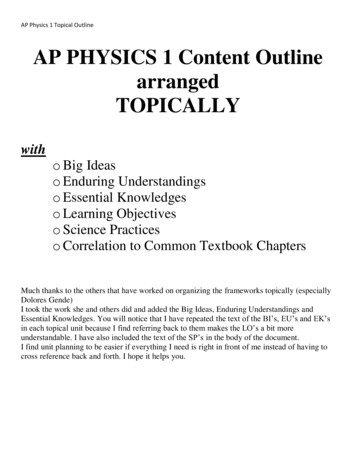
Transcription
AP Physics 1 Topical OutlineAP PHYSICS 1 Content OutlinearrangedTOPICALLYwitho Big Ideaso Enduring Understandingso Essential Knowledgeso Learning Objectiveso Science Practiceso Correlation to Common Textbook ChaptersMuch thanks to the others that have worked on organizing the frameworks topically (especiallyDolores Gende)I took the work she and others did and added the Big Ideas, Enduring Understandings andEssential Knowledges. You will notice that I have repeated the text of the BI’s, EU’s and EK’sin each topical unit because I find referring back to them makes the LO’s a bit moreunderstandable. I have also included the text of the SP’s in the body of the document.I find unit planning to be easier if everything I need is right in front of me instead of having tocross reference back and forth. I hope it helps you.
AP Physics 1 Topical OutlineKINEMATICS Reference Frames and DisplacementAverage Velocity and Instantaneous VelocityMotion at Constant AccelerationFalling ObjectsAdding Vectors by ComponentsProjectile Motion: Projectiles fired horizontally and at an angleGraphical Analysis of MotionGIANCOLI (7e): Chapter 2 (2-1 through 2-8) and Chapter 3 (3-1, 3-4 through 3-6, 3-8)ETKINA: Chapter 1 (1-1 through 1-9) and Chapter 3 (3-1, 3-4 through 3-6, 3-8)KNIGHT (3e): Chapter 1 (1-1 through 1-5); Chapter 2 (2-1 through 2-8); Chapter 3 (3-1, 3-5 through 3-7)CUTNELL (9e): Chapter 2 (2-1 through 2-8) and Chapter 3 (3-1 through 3-5)SERWAY (10e): Chapter 2 (2-1 through 2-6) and Chapter 3 (3-1 through 3-5)WALKER (4e): Chapter 2 (2-1 through 2-7); Chapter 3 (3-1 through 3-3, 3-5, 3-6); Chapter 4 (4-1 through 4-5)BIG IDEA 3: The interactions of an object with other objects can be described by forces.An object either has no internal structure or can be analyzed without reference to its internal structure. Aninteraction between two objects causes changes in the translational and/or rotational motion of each object. Whenmore than one interaction is involved, an object’s change in motion is determined by the combination ofinteractions (the net force). We know of three fundamental interactions or forces in nature: the gravitational force,the electroweak force, and the strong force. The electroweak force unifies the electromagnetic force and the weakforce. These two aspects of the electroweak force dominate at different scales, so are discussed separately. Thesefundamental forces are dominant at different length scales, and all other known “forces” are manifestations of oneor the other of these fundamental interactions. The fundamental forces determine both the structure of objects andthe motion of objects, from the very small molecular scale (micro and molecular machines and chemical reactions),to the motion of everyday objects such as automobiles and wind turbines, to the motion of tectonic plates, to themotion of objects and systems at the cosmological scale.Enduring Understanding 3.A:All forces share certain common characteristics when considered by observers in inertial referenceframes.The description of motion, including such quantities as position, velocity, or acceleration, depends on theobserver, specifically on the reference frame. When the interactions of objects are considered, we only considerthe observers in inertial reference frames. In such reference frames, an object that does not interact with anyother objects moves at constant velocity. In inertial reference frames, forces are detected by their influence onthe motion (specifically the velocity) of an object. So force, like velocity, is a vector quantity. A force vectorhas magnitude and direction. When multiple forces are exerted on an object, the vector sum of these forces,referred to as the net force, causes a change in the motion of the object. The acceleration of the object isproportional to the net force. If a component of the acceleration is observed to be zero, then the sum of thecorresponding force components must be zero. If one object exerts a force on a second object, the second objectalways exerts a force of equal magnitude but opposite direction on the first object. These two forces are knownas an action-reaction pair.
AP Physics 1 Topical OutlineEssential Knowledge 3.A.1: An observer in a particular reference frame can describe the motion of an objectusing such quantities as position, displacement, distance, velocity, speed, and acceleration.a. Displacement, velocity, and acceleration are all vector quantities.b. Displacement is change in position. Velocity is the rate of change of position with time. Acceleration isthe rate of change of velocity with time. Changes in each property are expressed by subtracting initialvalues from final values.c. A choice of reference frame determines the direction and the magnitude of each of these quantities.3.A.1.1: The student is able to express the motion of an object using narrative, mathematical, and graphicalrepresentations.[SP 1.5, 2.1, 2.2]1.5 The student can reexpress key elements of natural phenomena across multiple representations in the domain.2.1 The student can justify the selection of a mathematical routine to solve problems.2.2 The student can apply mathematical routines to quantities that describe natural phenomena.3.A.1.2: The student is able to design an experimental investigation of the motion of an object.[SP 4.2]4.2 The student can design a plan for collecting data to answer a particular scientific question.3.A.1.3: The student is able to analyze experimental data describing the motion of an object and is able toexpress the results of the analysis using narrative, mathematical, and graphical representations.[SP 5.1]5.1 The student can analyze data to identify patterns or relationships.
AP Physics 1 Topical OutlineDYNAMICS ForcesFree-Body-DiagramsNewton’s Laws of MotionMass and WeightApplications Involving Friction, InclinesGIANCOLI (7e): Chapter 4 (4-1 through 4-8)ETKINA: Chapter 2 (2-1 through 2-10) and Chapter 3 (3-1through 3-4, 3-6)KNIGHT (3e): Chapter 4 (4-1 through 4-7); Chapter 5 (5-1 through 5-8)CUTNELL (9e): Chapter 4 (4-1 through 4-13)SERWAY (10e): Chapter 4 (4-1 through 4-6)WALKER (4e): Chapter 5 (5-1 through 5-7) and Chapter 6 (6-1 through 6-5)BIG IDEA 1: Objects and systems have properties such as mass and charge. Systems mayhave internal structure.This big idea collects the properties of matter into one area so that they can be employed in other big ideas. The universecontains fundamental particles with no internal structure such as electrons, and systems built from fundamental particles,such as protons and neutrons. These further combine to form atoms, molecules, and macroscopic systems, all of whichhave internal structures.A system has various attributes or “properties” that determine how it behaves in different situations. When the propertiesof the system depend on the internal structure of the system, we must treat it as a system. In other cases, the properties ofinterest may not depend on the internal structure — in AP Physics we call these objects. For example, the free-fall motionof a ball can be understood without consideration of the internal structure of the ball, so in this case the ball can betreated as an object. Objects and systems have properties that determine their interactions with other objects and systems.The choice of modeling something as an object or a system is a fundamental step in determining how to describe andanalyze a physical situation.Enduring Understanding 1.C:Objects and systems have properties of inertial mass and gravitational mass that are experimentallyverified to be the same and that satisfy conservation principles.Inertial mass is the property of an object or a system that determines how its motion changes when it interacts with other objects orsystems. Gravitational mass is the property of an object or a system that determines the magnitude of its gravitational interactionwith other objects, systems, or gravitational fields. From these definitions, classically, there is no expectation that these quantitieswould be identical. Einstein’s assumption that these two quantities, experimentally verified to be equivalent, are in fact the same, isfundamental to the general theory of relativity (which is not part of this course).Mass is conserved in any process, such as change of shape, change of state, or dissolution, when it is not converted to energy or whenenergy is not converted to mass. Mass is a central concept in this course; further discussions of mass are found throughout.Essential Knowledge 1.C.1: Inertial mass is the property of an object or a system that determines how itsmotion changes when it interacts with other objects or systems.1.C.1.1: The student is able to design an experiment for collecting data to determine the relationship betweenthe net force exerted on an object its inertial mass and its acceleration. [SP 4.2]4.2 The student can design a plan for collecting data to answer a particular scientific question.
AP Physics 1 Topical OutlineEssential Knowledge 1.C.3: Objects and systems have properties of inertial mass and gravitational mass thatare experimentally verified to be the same and that satisfy conservation principles.1.C.3.1: The student is able to design a plan for collecting data to measure gravitational mass and to measureinertial mass and to distinguish between the two experiments. [SP 4.2]4.2 The student can design a plan for collecting data to answer a particular scientific question.BIG IDEA 2: Fields existing in space can be used to explain interactions.All of the fundamental forces, including the gravitational force and the electric and magnetic forces, are exerted “at adistance”; the two objects involved in the interaction do not “physically touch” each other. To understand and calculatesuch forces, it is often useful to model them in terms of fields, which associate a value of some quantity with every pointin space. Forces are vectors and so the associated fields are also vectors, having a magnitude and direction assigned toeach point in space. A field model is also useful for describing how scalar quantities, for instance, temperature andpressure, vary with position. In general, a field created by an array of “sources” can be calculated by combining the fieldscreated by the individual source objects. This is known as the principle of superposition. For a gravitational field thesource is an object with mass. For an electric field the source is an object with electric charge. For a magnetic field thesource is a magnet or a moving object with electric charge. Visual representations are extensively used by physicists inthe analysis of many situations. A broadly used example across many applications involving fields is a map of isolinesconnecting points of equal value for some quantity related to a field, such as topographical maps that display lines ofapproximately equal gravitational potential.Enduring Understanding 2.B:A gravitational field is caused by an object with mass.The gravitational field is the field most accessible to students. The effect of a gravitational field on an object with mass m positionedin the field is a force of magnitude mg that points in the direction of the field. The gravitational field can be representedmathematically. The gravitational field at a point in space due to a spherical object with mass M is a vector whose magnitude is equalto the gravitational force per unit of mass placed at that point. The direction of the field at the point is toward the center of mass of thesource object.The magnitude of the field outside the object is equal tog GM, where r is the distance between the center of mass of the objectr2and the point of interest and G is a constant. As with any vector field, a gravitational field can be represented by a drawing that showsarrows at points that are uniformly distributed in space.Essential Knowledge 2.B.1: A gravitational field at the location of an object with mass m causes agravitational force of magnitude mg to be exerted on the object in the direction of the field.a. On Earth, this gravitational force is called weight.b. The gravitational field at a point in space is measured by dividing the gravitational force exerted bythe field on a test object at that point by the mass of the test object and has the same direction as theforce.c. If the gravitational force is the only force exerted on the object, the observed free-fall acceleration ofthe object (in meters per second squared) is numerically equal to the magnitude of the gravitationalfield (in newtons/kilogram) at that location.⃗⃗ to calculate the gravitational force on an object with mass m in a2.B.1.1: The student is able to apply 𝐅 𝑚𝒈gravitational field of strength g in the context of the effects of a net force on objects and systems.[SP 2.2, 7.2]2.2 The student can apply mathematical routines to quantities that describe natural phenomena.7.2 The student can connect concepts in and across domain(s) to generalize or extrapolate in and/or across enduringunderstandings and/or big ideas.
AP Physics 1 Topical OutlineBIG IDEA 3: The interactions of an object with other objects can be described by forces.An object either has no internal structure or can be analyzed without reference to its internal structure. An interactionbetween two objects causes changes in the translational and/or rotational motion of each object. When more than oneinteraction is involved, an object’s change in motion is determined by the combination of interactions (the net force). Weknow of three fundamental interactions or forces in nature: the gravitational force, the electroweak force, and the strongforce. The electroweak force unifies the electromagnetic force and the weak force. These two aspects of the electroweakforce dominate at different scales, so are discussed separately. These fundamental forces are dominant at different lengthscales, and all other known “forces” are manifestations of one or the other of these fundamental interactions. Thefundamental forces determine both the structure of objects and the motion of objects, from the very small molecular scale(micro and molecular machines and chemical reactions), to the motion of everyday objects such as automobiles and windturbines, to the motion of tectonic plates, to the motion of objects and systems at the cosmological scale.Enduring Understanding 3.A:All forces share certain common characteristics when considered by observers in inertial referenceframes.The description of motion, including such quantities as position, velocity, or acceleration, depends on the observer, specifically on thereference frame. When the interactions of objects are considered, we only consider the observers in inertial reference frames. In suchreference frames, an object that does not interact with any other objects moves at constant velocity. In inertial reference frames, forcesare detected by their influence on the motion (specifically the velocity) of an object. So force, like velocity, is a vector quantity. Aforce vector has magnitude and direction. When multiple forces are exerted on an object, the vector sum of these forces, referred to asthe net force, causes a change in the motion of the object. The acceleration of the object is proportional to the net force. If acomponent of the acceleration is observed to be zero, then the sum of the corresponding force components must be zero. If one objectexerts a force on a second object, the second object always exerts a force of equal magnitude but opposite direction on the first object.These two forces are known as an action-reaction pair.Essential Knowledge 3.A.2: Forces are described by vectors.a. Forces are detected by their influence on the motion of anb. Forces have magnitude and direction.object.3.A.2.1: The student is able to represent forces in diagrams or mathematically using appropriately labeledvectors with magnitude, direction, and units during the analysis of a situation. [SP 1.1]1.1 The student can create representations and models of natural or man–made phenomena and systems in thedomain.Essential Knowledge 3.A.3: A force exerted on an object is always due to the interaction of that object withanother object.a. An object cannot exert a force on itself.b. Even though an object is at rest, there may be forces exerted on that object by other objects.c. The acceleration of an object, but not necessarily its velocity, is always in the direction of the net forceexerted on the object by other objects.3.A.3.1: The student is able to analyze a scenario and make claims (develop arguments, justify assertions) aboutthe forces exerted on an object by other objects for different types of forces or components of forces. [SP 6.4,7.2]6.4 The student can make claims and predictions about natural phenomena based on scientific theories and models.7.2 The student can connect concepts in and across domain(s) to generalize or extrapolate in and/or across enduringunderstandings and/or big ideas.
AP Physics 1 Topical Outline3.A.3.2: The student is able to challenge a claim that an object can exert a force on itself. [SP 6.1]6.1 The student can justify claims with evidence.3.A.3.3: The student is able to describe a force as an interaction between two objects and identify both objectsfor any force. [SP 1.4]1.4 The student can use representations and models to analyze situations or solve problems qualitatively andquantitatively.Essential Knowledge 3.A.4: If one object exerts a force on a second object, the second object always exerts aforce of equal magnitude on the first object in the opposite direction.3.A.4.1: The student is able to construct explanations of physical situations involving the interaction of bodiesusing Newton’s third law and the representation of action-reaction pairs of forces. [SP 1.4, 6.2]1.4 The student can use representations and models to analyze situations or solve problems qualitatively andquantitatively.6.2 The student can construct explanations of phenomena based on evidence produced through scientific practices.3.A.4.2: The student is able to use Newton’s third law to make claims and predictions about the action-reactionpairs of forces when two objects interact. [SP 6.4, 7.2]6.4 The student can make claims and predictions about natural phenomena based on scientific theories and models.7.2 The student can connect concepts in and across domain(s) to generalize or extrapolate in and/or across enduringunderstandings and/or big ideas.3.A.4.3: The student is able to analyze situations involving interactions among several objects by using freebody diagrams that include the application of Newton’s third law to identify forces. [SP 1.4]1.4 The student can use representations and models to analyze situations or solve problems qualitatively andquantitatively.Enduring Understanding 3.B:Classically, the acceleration of an object interacting with other objects can be predicted by usingNewton’s second law describes the acceleration when one or more forces are exerted on an object. The object’s acceleration alsodepends on its inertial mass. Newton’s second law is easier to appreciate when the law is written aswhich underscores thecause–effect relationship. In a free-body diagram, the choice of appropriate axes (usually one axis parallel to the direction in which theobject will accelerate) and the resolution of forces into components along the chosen set of axes are essential parts of the process ofanalysis. The set of component forces along an axis corresponds to the list of forces that are combined to cause acceleration alongthat axis. Constant forces will yield a constant acceleration, but restoring forces, proportional to the displacement of an object, causeoscillatory motion. In this course, the oscillatory solution should be the result of an experiment, rather than the solution of thedifferential equation.Essential Knowledge 3.B.1: If an object of interest interacts with several other objects, the net force is thevector sum of the individual forces.3.B.1.1: The student is able to predict the motion of an object subject to forces exerted by several objects usingan application of Newton’s second law in a variety of physical situations with acceleration in one dimension.[SP 6.4, 7.2]6.4 The student can make claims and predictions about natural phenomena based on scientific theories and models.7.2 The student can connect concepts in and across domain(s) to generalize or extrapolate in and/or across enduringunderstandings and/or big ideas.3.B.1.2: The student is able to design a plan to collect and analyze data for motion (static, constant, or
AP Physics 1 Topical Outlineaccelerating) from force measurements and carry out an analysis to determine the relationship between the netforce and the vector sum of the individual forces. [SP 4.2, 5.1]4.2 The student can design a plan for collecting data to answer a particular scientific question.5.1 The student can analyze data to identify patterns or relationships.3.B.1.3: The student is able to reexpress a free-body diagram representation into a mathematical representationand solve the mathematical representation for the acceleration of the object. [SP 1.5, 2.2]1.5 The student can re-express key elements of natural phenomena across multiple representations in the domain.2.2 The student can apply mathematical routines to quantities that describe natural phenomena.Essential Knowledge 3.B.2: Free-body diagrams are useful tools for visualizing forces being exerted on asingle object and writing the equations that represent a physical situation.a. An object can be drawn as if it was extracted from its environment and the interactions with theenvironment identified.b. A force exerted on an object can be represented as an arrow whose length represents the magnitude ofthe force and whose direction shows the direction of the force.c. A coordinate system with one axis parallel to the direction of the acceleration simplifies the translationfrom the free- body diagram to the algebraic representation.3.B.2.1: The student is able to create and use free-body diagrams to analyze physical situations to solveproblems with motion qualitatively and quantitatively. [SP 1.1, 1.4, 2.2]1.1 The student can create representations and models of natural or man–made phenomena and systems in thedomain.1.4 The student can use representations and models to analyze situations or solve problems qualitatively andquantitatively.2.2 The student can apply mathematical routines to quantities that describe natural phenomena.Enduring Understanding 3.C:At the macroscopic level, forces can be categorized as either long-range (action-at-a-distance) forces orcontact forces.In Big Idea 3, the behavior of an object is analyzed without reference to the internal structure of the object. Internal structure isincluded in Big Idea 4. There are a small number of forces that occur in nature, and the macroscopic ones are considered here. Theidentification of forces is a key step in the analysis of mechanical systems.Gravitational forces, electric forces, and magnetic forces between objects are all evident on the macroscopic scale. The gravitationalforce is a weaker force than the electric or magnetic force. However, on the larger scale, the gravitational force dominates. Electricforces are dominant in determining the properties of the objects in our everyday experience. However, the many electrically chargedparticles that interact make the treatment of this everyday force very complex. Introducing new concepts such as the frictional force asaverages over the many particles reduces the complexity. Contact forces (e.g., frictional force, buoyant force) result from theinteraction of one object touching another object andare ultimately due to microscopic electric forces. The frictional force is due to the interaction between surfaces at rest or in relativemotion. Buoyant force is caused by the difference in pressure, or force per unit area, exerted on the different surfaces of the object. Itis important for students to study each of these forces and to use free-body diagrams to analyze the interactions between objects.Essential Knowledge 3.C.4:Contact forces result from the interaction of one object touching another object, and they arise from interatomicelectric forces. These forces include tension, friction, normal, spring (Physics 1), and buoyant (Physics 2).3.C.4.1: The student is able to make claims about various contact forces between objects based on themicroscopic cause of those forces. [SP 6.1]6.1 The student can justify claims with evidence.3.C.4.2: The student is able to explain contact forces (tension, friction, normal, buoyant, spring) as arising from
AP Physics 1 Topical Outlineinteratomic electric forces and that they therefore have certain directions. [SP 6.2]6.2 The student can construct explanations of phenomena based on evidence produced through scientific practices.BIG IDEA 4: Interactions between systems can result in changes in those systems.A system is a collection of objects, and the interactions of such systems are an important aspect of understanding thephysical world. The concepts and applications in Big Idea 3, which concerned only objects, can be extended todiscussions of such systems. The behavior of a system of objects may require a specification of their distribution, whichcan be described using the center of mass. The motion of the system is then described by Newton’s second law as appliedto the center of mass. When external forces or torques are exerted on a system, changes in linear momentum, angularmomentum, and/or kinetic, potential, or internal energy of the system can occur. Energy transfers, particularly, are at theheart of almost every process that is investigated in the AP sciences. The behavior of electrically charged and magneticsystems can be changed through electromagnetic interactions with other systems.Enduring Understanding 4.A:The acceleration of the center of mass of a system is related to the net force exerted on the system, whereThe concept of center of mass allows one to analyze and predict the motion of a system using an approach very similar to the wayone can analyze and predict the motion of an object. When dealing with a system of objects, it is useful to first identify the forces thatare “internal” and “external” to the system. The internal forces are forces that are exerted between objects in the system, while theexternal forces are those that are exerted between the system’s objects and objects outside the system. Internal forces do not affect themotion of the center of mass of the system. Since all the internal forces will be action-reaction pairs, they cancel one another. Thus,F will be equivalent to the sum of all the external forces, so the acceleration of the center of mass of the system can benetcalculated using. Hence, many of the results for the motion of an object can be applied to the motion of the center of massof a system.Essential Knowledge 4.A.1: The linear motion of a system can be described by the displacement, velocity, andacceleration of its center of mass.4.A.1.1 The student is able to use representations of the center of mass of an isolated two-object system toanalyze the motion of the system qualitatively and semiquantitatively. [SP 1.2, 1.4, 2.3, 6.4]1.2 The student can describe representations and models of natural or man–made phenomena and systems in thedomain.1.4 The student can use representations and models to analyze situations or solve problems qualitatively andquantitatively.2.3 The student can estimate numerically, quantities that describe natural phenomena.6.4 The student can make claims and predictions about natural phenomena based on scientific theories and models.Essential Knowledge 4.A.2: The acceleration is equal to the rate of change of velocity with time, and velocityis equal to the rate of change of position with time.d. The acceleration of the center of mass of a system is directly proportional to the net force exerted on itby all objects interacting with the system and inversely proportional to the mass of the system.e. Force and acceleration are both vectors, with acceleration in the same direction as the net force.
AP Physics 1 Topical Outline4.A.2.1: The student is able to make predictions about the motion of a system based on the fact that accelerationis equal to the change in velocity per unit time, and velocity is equal to the change in position per unit time.[SP 6.4]6.4 The student can make claims and predictions about natural phenomena based on scientific theories and models.4.A.2.2: The student is able to evaluate using given data whether all the forces on a system or whether all theparts of a system have been identified. [SP 5.3]5.3 The student can evaluate the evidence provided by data sets in relation to a particular scientific question.4.A.2.3: The student is able to create mathematical models and analyze graphical relationships for acceleration,velocity, and position of the center of mass of a system and use them to calculate properties of the motion of thecenter of mass of a system. [SP 1.4, 2.2]1.4 The student can use representations and models to analyze situations or solve problems qualitatively andquantitatively.2.2 The student can apply mathematical routines to quantities that describe natural phenomena.Essential Knowledge 4.A.3: Forces that systems exert on each other are due to interactions between objects inthe systems. If the interacting objects are parts of the same system, there will be no change in the center-ofmass velocity of that system.4.A.3.1: The student is able to apply Newton’s second law to systems to calculate the change in the center-ofmass velocity when an external force is exerted on the system. [SP 2.2]2.2 The student can apply mathematical routines to quantities that describe natural phenomena.4.A.3.2: The student is able to use visual or mathematical representations of the f
AP Physics 1 Topical Outline Essential Knowledge 1.C.3: Objects and systems have properties of inertial mass and gravitational mass that are experimentally verified to be the same and that satisfy conservation principles. 1.C.3.1: The student is able to design a plan for collecting data to measure gravitational mass and to m
